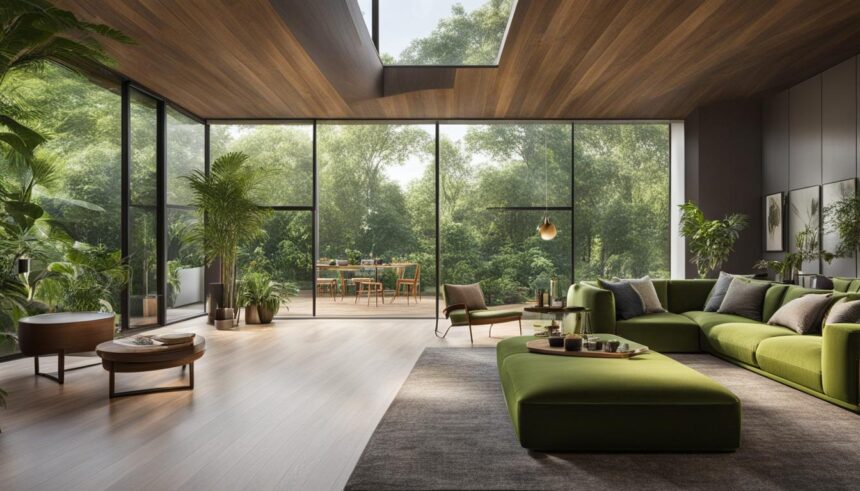In recent years, nature-inspired design has become popular in architecture and interior design. But what exactly does this mean? At its core, it’s about reconnecting humans with nature by incorporating natural elements into indoor spaces. This approach goes beyond aesthetics, focusing on how nature positively impacts well-being, health, and productivity. Integrating greenery, natural light, and organic textures into indoor environments creates spaces that feel calming and rejuvenating. But how can one bring these principles into one’s home or workspace? Let’s explore.
The Core Principles of Nature-Inspired Design
This biophilic design approach involves more than just adding a few plants. It’s about using design elements to replicate nature in ways that benefit the mind and body. Some key aspects include natural lighting, proper ventilation, and the inclusion of greenery. Furthermore, it promotes using materials and textures derived from the natural world, such as wood, stone, and water features. These elements aim to create an environment that soothes the senses and fosters a connection with the outdoors.
One of the standout features is the incorporation of organic shapes and patterns. Winding paths, curved furniture, wallpaper miming tree branches or ocean waves exemplify how natural elements evoke serenity and comfort. Moreover, it’s essential to integrate views of nature, whether through windows overlooking gardens or artwork.
Benefits of Nature-Inspired Design
Why should one consider adopting this design philosophy? Research shows that reconnecting with nature can significantly reduce stress, increase productivity, and boost creativity. In today’s world, where people spend much time indoors, integrating outdoor elements can create a healthier and more balanced environment.
In workspaces, this approach can help reduce fatigue and enhance job satisfaction. Imagine working in a space filled with natural light, greenery, and fresh air. It’s much more inviting than a plain, windowless room. Similarly, homes with nature-infused designs feel more welcoming and relaxing, providing a peaceful retreat after a long day.
Not only does this style benefit mental health, but it can also positively affect physical health. Improved air quality, facilitated by better ventilation and the presence of plants, is just one example. Natural materials like wood and stone are also safer than synthetic ones, which can release harmful chemicals over time.
Simple Ways to Bring Nature Indoors
You don’t need to remodel your home to incorporate nature-inspired design completely. Small changes can have a significant impact. Start by maximising natural light. Opening blinds, installing skylights, or using mirrors to reflect light can brighten a room and make it feel more open.
Next, consider adding plants. Biophilic design emphasises greenery as one of the easiest ways to bring life and freshness into a space. Whether it’s small potted plants or a statement piece like a large indoor tree, plants naturally improve air quality and elevate the mood of a room.
Textures are another critical element. Choose materials that echo the natural world. Wooden furniture, stone countertops, and woven textiles can all create a warm, inviting atmosphere. Small touches like a wool rug or linen curtains can make a noticeable difference.
How Nature-Inspired Design Improves Well-Being
Scientific research backs the benefits of this interior design philosophy. Studies have shown that environments incorporating natural elements can reduce cortisol levels, the hormone linked to stress. Moreover, exposure to natural light can help regulate circadian rhythms, leading to better sleep and overall health.
A nature-based workspace can help maintain focus and creativity for those who work from home. Promoting an environment that feels more open and connected to nature makes people feel energised and less confined. These principles aren’t limited to homes, either. Schools, offices, and hospitals have begun integrating these natural elements to enhance the well-being of those who spend time there.
Environmental Benefits of Nature-Inspired Design
Beyond personal advantages, nature-based design also contributes significantly to environmental sustainability. Using natural, locally sourced materials like wood, bamboo, or stone reduces the need for synthetic, mass-produced materials. This approach lowers the carbon footprint, supports renewable resources, and fosters eco-conscious manufacturing practices.
Additionally, sustainable materials are often more durable and healthier for indoor environments, reducing the release of harmful chemicals over time. These elements promote a circular economy and encourage long-lasting, environmentally responsible designs. Buildings that maximise natural light and ventilation reduce the need for artificial lighting and air conditioning, leading to significant energy savings.
Incorporating natural materials like wood, stone, and sustainable fabrics further enhances eco-efficiency. Over time, these spaces become cost-effective and environmentally friendly and contribute to healthier indoor air quality and a reduced carbon footprint. By embracing natural design elements, such buildings offer long-term benefits for both occupants and the planet.
Integrating biophilic design into indoor spaces offers mental and physical health benefits. From reducing stress to enhancing creativity, this approach transforms interiors into places of calm and rejuvenation. Whether through small changes like adding plants and natural textures or more significant design shifts, nature-inspired design makes indoor environments feel more balanced. By bringing the outdoors in, you improve your surroundings and elevate your quality of life. Hence, isn’t it time to embrace this nature-centred trend and see how it can transform your space?






